| Srl | Item |
| 1 |
ID:
146015
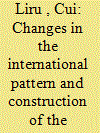

|
|
|
|
|
| Summary/Abstract |
Multipolarization and power diffusion mean the US is losing gradually its overweening dominance. China, Europe, Russia, Japan and India are increasingly independent, and the changing international pattern is allowing middle powers more swing room in the construction of a new international order.
|
|
|
|
|
|
|
|
|
|
|
|
|
|
|
|
| 2 |
ID:
148161
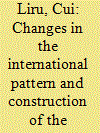

|
|
|
|
|
| Summary/Abstract |
In response to multipolarity, the Obama administration has adjusted its foreign policies but still faces both internal and external constraints. In terms of the Asia-Pacific Region, Sino-US relations are of vital importance to the shaping of the future order, which calls for strategic cooperation in response to various threats despite growing competition between each other.
|
|
|
|
|
|
|
|
|
|
|
|
|
|
|
|
| 3 |
ID:
133855
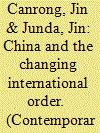

|
|
|
|
|
| Publication |
2014.
|
| Summary/Abstract |
From the beginning of 2014, the international order has undergone some quite dramatic changes in several parts of the world. The Ukrainian political crisis has gradually evolved into a U.S-Russia confrontation two decades after the end of cold war. In the Middle East, the extremist group, the Islamic State of Iraq and Al Sham (ISIS) invaded Iraq gaining much territory in the north of the country. Iraq has become a new unstable element in the Middle East. In Africa, the aftershock of the Arab Spring can be seen most prominently in Egypt and Libya. South Sudan and Central Africa are plagued by civil war. In the Asia-Pacific region Sino-Vietnam and Sino-Japanese Conflict have escalated and Japan has lifted a ban on collective self defence which threaten China's neighborhood security and regional stability.
|
|
|
|
|
|
|
|
|
|
|
|
|
|
|
|
| 4 |
ID:
133853


|
|
|
|
|
| Publication |
2014.
|
| Summary/Abstract |
The global order was set in place following the end of the Second World War by a consortium of western countries headed by the U. S. since then, major western countries have strived to maintain their long dominance in global politics and economics. With the rise of nationalist movements, former colonies gained their independence, and many developing countries joined the UN in recent years the economies of the emerging powers have grow rapidly and they have also joined WTO.
|
|
|
|
|
|
|
|
|
|
|
|
|
|
|
|
| 5 |
ID:
133852
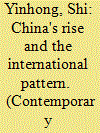

|
|
|
|
|
| Publication |
2014.
|
| Summary/Abstract |
Three basic elements stand out in the international pattern: global power distribution, the system of international norms and the transnational values systems, all of which are of vital importance in the interaction between China's rise and the future international pattern.
|
|
|
|
|
|
|
|
|
|
|
|
|
|
|
|
| 6 |
ID:
133850
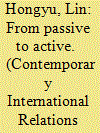

|
|
|
|
|
| Publication |
2014.
|
| Summary/Abstract |
As one of the victorious allies of World War - I, China attended the Paris Peace Conference in 1919. Toa certain extent, the conference can be regarded as the true beginning of global governance. It was followed by the establishment of the Versailles-Washington System. The first international pattern with world participation
|
|
|
|
|
|
|
|
|
|
|
|
|
|
|
|
| 7 |
ID:
133854
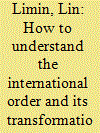

|
|
|
|
|
| Publication |
2014.
|
| Summary/Abstract |
What is the international order? Professor Zhoa Xiaochun define it as the standards and specifications established by the members of the international system in order to maintain its stability and normal operation as well coordinating and addressing international affairs, and acting as a guarantee mechanism, a decision making process and providing rules of agenda.
|
|
|
|
|
|
|
|
|
|
|
|
|
|
|
|
| 8 |
ID:
156368
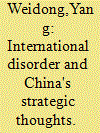

|
|
|
|
|
| Summary/Abstract |
Since the 2008 financial crisis, international political and economic disorder has become obvious. Major reasons are the decline of US-led Western developed economies global influence; US and otherWestern countries inaction or ineffective actions; power diffusion allowing non-state actors to intervene; a global governance short of needed rules; and mainstream economic theory's overemphasis on market roles. International disorder is a long term process posing a potential threat to China's national interests.
|
|
|
|
|
|
|
|
|
|
|
|
|
|
|
|
| 9 |
ID:
133851
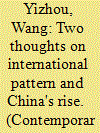

|
|
|
|
|
| Publication |
2014.
|
| Summary/Abstract |
The substantial change in the international system since the end of the World War - II has been a boon to non-western nations, which make up three quarters of all the countries today. Most nationalist, populations and countries that had little freedom and almost no voice have representation today in the United Nations and G20,and they benefit from more international investment. Enterprising BRICS countries hold a competitive position in manufacturing, infrastructure construction and international trade. Their role in international rule formations has changed from a taker to an instructor, allowing them to tread their individual development path more confidently.
|
|
|
|
|
|
|
|
|
|
|
|
|
|
|
|